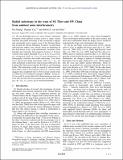Radial anisotropy in the crust of SE Tibet and SW China from ambient noise interferometry
Author(s)
Huang, Hui; Yao, Huajian; van der Hilst, Robert D
Downloadvan der Hilst_Radial anisotrophy.pdf (632.2Kb)
PUBLISHER_POLICY
Publisher Policy
Article is made available in accordance with the publisher's policy and may be subject to US copyright law. Please refer to the publisher's site for terms of use.
Terms of use
Metadata
Show full item recordAbstract
We use Rayleigh and Love wave Green's functions estimated from ambient seismic noise to study crustal structure and radial anisotropy in the tectonically complex and seismically active region west of the Sichuan Basin and around the Eastern Himalaya Syntaxis. In agreement with previous studies, low velocity zones are ubiquitous in the mid-lower crust, with substantial variations both laterally and vertically. Discrepancies between 3-D shear velocity from either Rayleigh (V[subscript SV]) or Love (V[subscript SH]) waves are examined both in view of non-uniqueness of tomographic solutions and radial anisotropy. Low shear wave speed and radial anisotropy with V[subscript SH] > V[subscript SV] are most prominent in mid-lower crust in area northwest to the Lijiang-Muli fault and around the Red River and Xiaojiang faults. This anisotropy could be caused by sub-horizontal mica fabric and its association with low velocity zones suggests mica alignment due to flow in deep crustal zones of relatively low mechanical strength.
Date issued
2010-11Department
Massachusetts Institute of Technology. Department of Earth, Atmospheric, and Planetary SciencesJournal
Geophysical Research Letters
Publisher
American Geophysical Union (AGU)
Citation
Huang, Hui, Huajian Yao, and Robert D. van der Hilst. “Radial Anisotropy in the Crust of SE Tibet and SW China from Ambient Noise Interferometry.” Geophysical Research Letters 37.21 (2010). ©2012 American Geophysical Union
Version: Final published version
ISSN
0094-8276